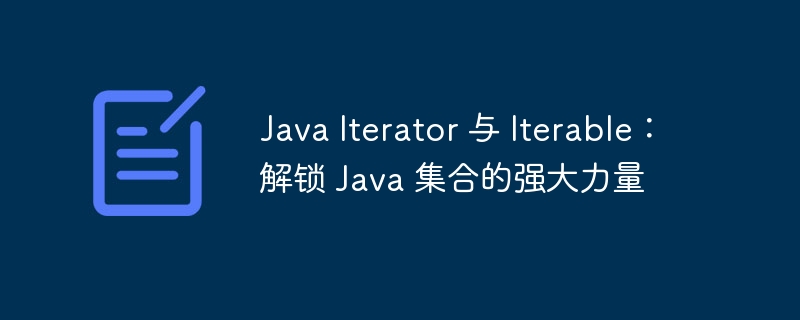Home >Java >javaTutorial >Java Iterator vs. Iterable: Unlocking the Power of Java Collections
Java Iterator vs. Iterable: Unlocking the Power of Java Collections
- PHPzforward
- 2024-02-19 19:00:231213browse

Java Iterator and Iterable are two important interfaces in the Java collection framework. They provide powerful operating capabilities for Java collections. In programming, proficiency in the Iterator and Iterable interfaces allows us to operate and manage collection elements more efficiently. In this article, PHP editor Banana will deeply discuss the usage methods and techniques of Java Iterator and Iterable interfaces to help readers unlock the powerful power of Java collections.
The Iterator interface defines hasNext() and next() methods for traversing collections. The hasNext() method is used to check whether there are any untraversed elements in the collection, and the next() method is used to return the current element and move it to the next element.
The Iterable interface defines the iterator() method, which returns an Iterator object for traversing the elements in the collection. Implementing classes of the Iterable interface can create their own Iterator objects to implement custom traversal behavior.
Using Iterator and Iterable can easily traverse the elements in the collection. The code example is as follows:
List<String> list = new ArrayList<>();
list.add("Apple");
list.add("Orange");
list.add("Banana");
// 使用 Iterator 遍历集合
Iterator<String> iterator = list.iterator();
while (iterator.hasNext()) {
String fruit = iterator.next();
System.out.println(fruit);
}
// 使用 Iterable 遍历集合
for (String fruit : list) {
System.out.println(fruit);
}
Output result:
Apple Orange Banana Apple Orange Banana
In the above example, we used a List to store strings, and then used Iterator and Iterable to traverse the elements in the List and print out the value of each element.
Iterator and Iterable provide Java developers with powerful tools for traversing elements in a collection. They help developers work with collection data more efficiently and write more robust and flexible code.
The following are some advantages of Iterator and Iterable:
- Provides a unified interface for traversing elements in collections, regardless of how these collections are implemented.
- Allows developers to customize the traversal order. For example, the elements in the collection can be traversed in order or in reverse order.
- You can stop traversing at any time without traversing the entire collection.
- You can use Iterator and Iterable to perform search and update operations in collections.
Mastering the usage of Iterator and Iterable, Java developers can process collection data more efficiently and write more robust and flexible code.
The above is the detailed content of Java Iterator vs. Iterable: Unlocking the Power of Java Collections. For more information, please follow other related articles on the PHP Chinese website!

